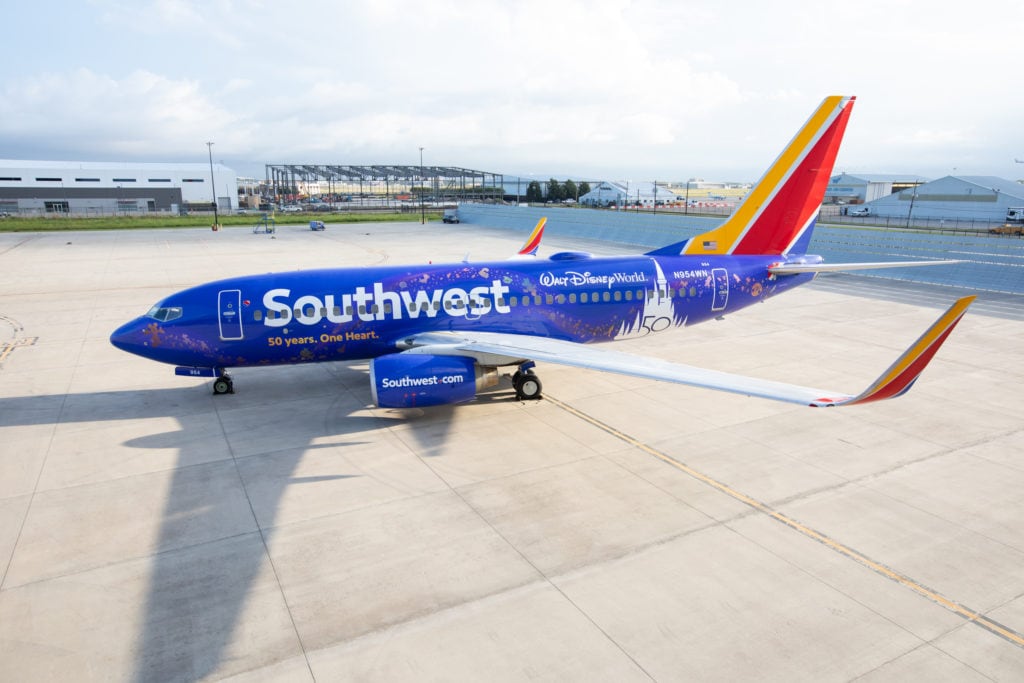Southwest to Trial Priority Boarding for Families
The week-long trial will take place at Atlanta Hartsfield-Jackson International Airport this December
by Lauren Smith
December 9, 2022

Photo: Courtesy of Southwest Airlines / Stephen M. Keller
Southwest Airlines is trialing a policy change that will allow families to board first to secure seats together, removing some of the stress of the airline’s free-for-all seating scheme.
Southwest has a long-standing policy of no assigned seating. Instead, passengers are given a boarding group (A, B, or C) and a number within it (e.g., A32, B15).
Open seating is stressful for families with children who want seats together. Adults traveling with children aged six and under are allowed to board after group A but before group B, regardless of their position. However, depending on the seat selections of group A and the number of families also trying to sit together, families may be separated or forced to appeal to fellow passengers to secure adjacent seats.

Photo: Courtesy of Southwest Airlines / Stephen M. Keller
But Southwest is now embarking on a limited trial of a new approach to reduce aircraft turn times.
During a week-long period in mid-December, at four departure gates at Atlanta Hartsfield–Jackson International Airport (ATL), families will be permitted to board Southwest flights first, as long as they sit behind row 15. Families that want to take advantage of priority boarding will gather in designated spaces at the gate.
A spokesperson for Southwest said that “altering the boarding process for families, which will be tested soon at one innovation station in our network, was mentioned as one idea, of many, in a larger discussion about evaluating the efficiency our boarding process.”
An ‘innovation station’ is Southwest lingo for an airport where it’s trialing new programs.
The spokesperson maintained that the test run “is not an indication of a forthcoming policy change.” But it could give hope to families worried about having young children seated rows away.
The change may also be a reaction to an intervention from the U.S. Department of Transportation (DOT). On July 8, the DOT’s Office of Aviation Consumer Protection issued a notice to airlines asking that they do everything they can to allow children under 13 to be seated next to an accompanying adult, free of charge.
The DOT stated that it would check back in with airlines in the fall to ensure they had made the necessary changes. In addition, it has suggested that regulatory action may be required “to ensure airlines’ seating policies and practices are not barriers to a young child being seated next to an adult family member or other accompanying adult.”

Photo: Courtesy of Southwest Airlines
In August, Southwest introduced a policy that allows travelers to upgrade their boarding number for a fee at check-in. However, the upgrade comes with a cost of at least $30 per flight segment per customer. So, if a passenger is trying to secure five seats for family members on two connecting flights, the cost could come to a hefty $300.
Southwest also offers EarlyBird Check-In, which automatically checks a passenger in immediately when check-in becomes available 24 hours before departure, guaranteeing a good boarding group from the start.
This feature costs $15 per one-way flight per passenger and is available from 36 hours before the flight.
The low-cost carrier is also exploring other changes to reduce the time its aircraft are at airport gates. These changes include giving flight attendants and gate staff tools to better communicate with each other when overhead luggage bins are full and digitizing dispatch-related documents and weather packets.
“All things are certainly on the table,” said Angela Marano, vice president of business transformation.
Currently, Southwest’s turnaround time for a Boeing 737-700 is 30 to 40 minutes, while the turn on the bigger 737-800 is 40 to 50 minutes. Time-saving measures could shave several minutes off these times, Southwest suggested, boosting efficiency and cutting costs.



